Ragi: The Nutritious Finger Millet
What is Ragi?
Ragi
- Ragi is an annual cereal crop belong to the Gramineae or Poaceae grass family of genus Eleusine coracana of millet group. It is an example of tetraploid which means it has 28 Nos of Chromosomes in it (2n=4x=28 chromosome) & it is self pollinating.
- Popularly it is known as “Finger millet” because of its appearance of the head of the grain which comprises of five spikes resembling the five fingers our hand. Finger millet or Ragi is minor cereal grain mainly cultivated in the tropical region in the desert & semi desert climate of Asian countries like India, Nepal & Srilanka as well as African countries like Ethiopian, Tanzania,Kenya & Uganda. This minor cereal crop can even cultivate at altitude over 2000m above the sea level even in drought affected area.
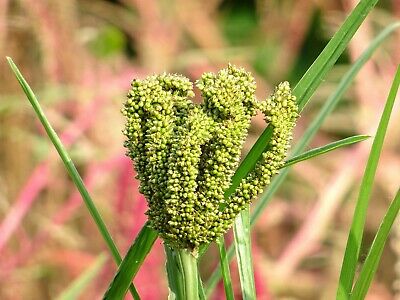
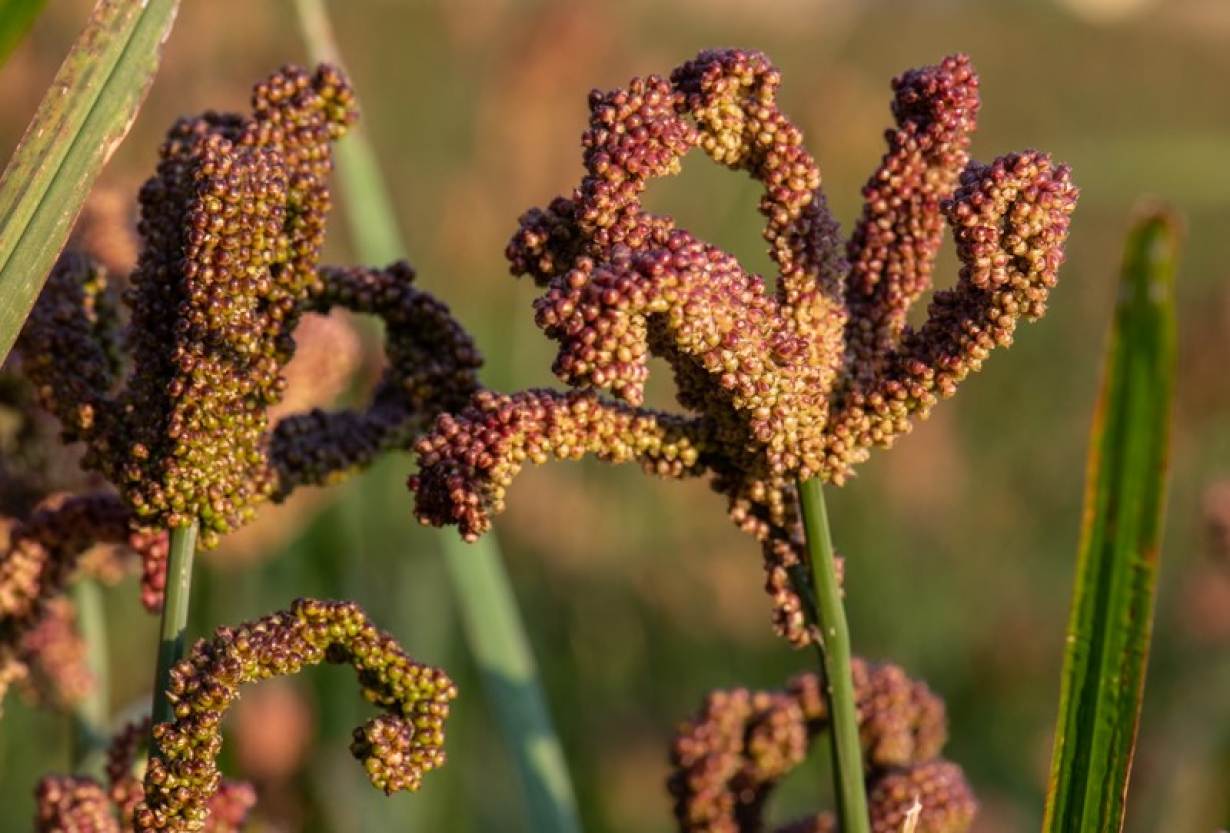
Pic source- eBay & ICRISAT
In India, it is extensively cultivated & consumed in Karnataka, TamilNadu, Maharastra & Uttrakhand and to a limited extent in the state like Odisha, Andhra Pradesh, Bihar, Gujrat, West Bengal, Goa, Jharkhand etc. It ranked 6th in terms of production after wheat, rice, maize, sorghum and bajra in India.
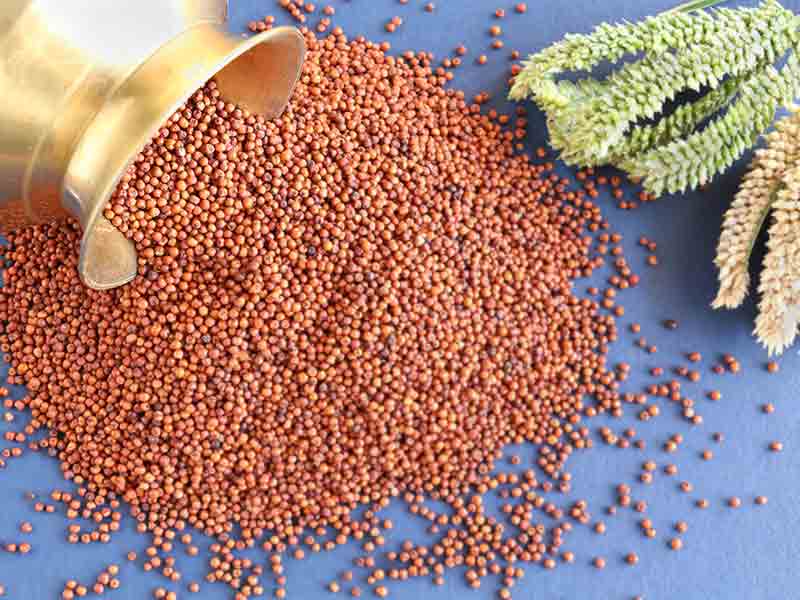
Pic source-Healthy dig
Common name of Ragi:-
- Scientific name- Eleusine coracana
- English name:- Finger millet, African millet, Ragi, Koracan.
- In French:-Eleusine cultivee or Coracan.
- In German & Denmark:- Fingerhirse
- In African countries:-Dagussa,Wimbi,mbege,Bulo,Ulezi .
- In Arabic:-Tailabon
- In Nepal:- Koddo, maruwa
- In Srilanka:-Kurakkan
- In Hindi:- Maduva (मंडुआ), marua (मड़ुआ), ragi (रागी)
- In Sanskrit:- Madhulika, mattakam
- In Urdu:- Mandwa, maruwa, Ragi
- In Tamil:-Kel-varaku(கேழ்வரகு),Aariyam(ஆரியம்)
- In Kannada & Telgu:- Ragi (ರಾಗಿ), tamidalu(తమిదలు)
- In Malayalam:-Panjapule
- In Marathi:-Nachani (नाचणी)
- In Gujrati & Konkani:- Bavato(બાવટો), nachni(નાચણી),nagali(નાગલી)
- In Assamese:- Maruba dhan (মৰুবা ধান)
- In Bengali:- Marwa
- In Orriya:- Mandia
- In Punjabi:- Mandal or mandhul (ਮੰਦਲ or ਮੰਢੁਲ)
- In Himachal Pradesh:- Kodra
Characteristic of Finger millet or Ragi grain:-
Ragi grain has spherical or globular in shape in a diameter of approx 1 to 1.5 millimetre (MM). Most of the cereal grain consists of pericarp, endosperm & germ. Approx 1000 ragi grain can weight upto 2.5gms
Pericarp of Ragi grain:- Pericarp is the outermost non-edible tissue of the grain commonly known as glume. Its pericarp is membranous and surround the entire seed which can be easily removed from the utricle by rubbing slightly by hand or even by soaking it in water. Prior to processing of the Ragi grains, its inedible outer pericarp tissue are removed from the kernel to convert into edible food grain.
Ragi grain has a unique five layered thick edible seed coat or testa which is brick red in color and tightly adheres to its endosperm. Its color is mainly due to the presence of flavonoids & tannins pigment. Its edible seed coat is rich in phytochemicals like dietary fiber and polyphenols and is also very high in minerals especially calcium.
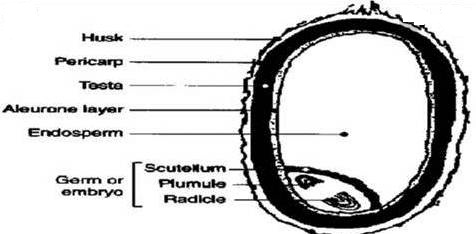
Pic source-researchgate
Endosperm of Ragi grain:- The largest component of the cereal kernel is the endosperm, which is a major storage tissue. Its endosperm is white in color which is tightly surrounded with hard 5 layered seed coat called testa which is brick red in color. The endosperm is soft & fragile and mostly composed of starch granules which are used to make flour. Its starch is mainly consisting of amylose and amylopectin in the range of 25: 75.
Ragi grains consist of approx 5–8% protein, 65–75% carbohydrates, 15–20% dietary fiber and 2.5–3.5% minerals. It has the highest calcium content (344 milligrams per 100gms of Ragi grain) among all cereal grain.
Finger millet grains are naturally gluten-free, non-acid-forming, easy to digest with low glycemic index foods. It is used as a substitute for wheat which contains gluten in the preparation of breads, chapatti, dosas & other food products.
The color of the Ragi grain can be of Brick red color to brown in color depending upon the variety of the grains grown in different region of India & other part of the world.
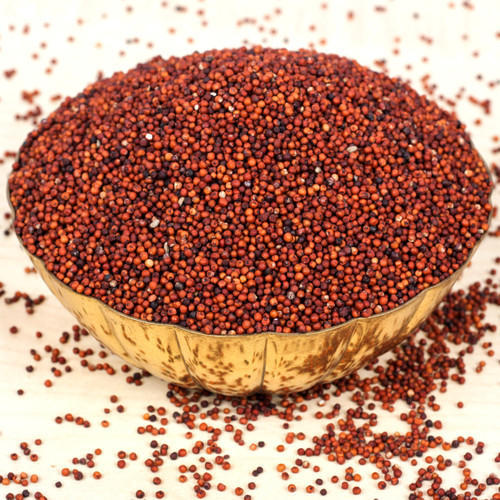
Pic source-Indiamart
A brief history of its cultivation:-
Finger millet is also one of the ancient cereal crop in the world. It is believed to have been originated in the highlands of Ethopia around 3000BCE. It arrived in India around 3000 years back, probably coming from trade with the Axumite Empire.

Pic source- Hindavi, The Kitchens of Indian History
Its cultivation is also mentioned in ancient India Sanskrit literature where it mentioned as “Nrtta-kondaka” means Dancing grain which is referred to Ragi grain. The word Ragi is perhaps originated from a Sanskrit word “Raga or Rajika” meaning Red because most of the ragi grain has brick red in color. Legend holds that Lord Rama, Indra and Hanuman all favoured ragi over rice, on the merits of its immediate and lasting attractiveness.
In the Deccan region, ragi is prepared in the form of rotti, bhakri, dosa, idli, porridge, pudding, or a large sphere (mudde) that is broken into pieces that are dipped into sambar.
Cultivation of Ragi:-
- Ragi or Finger millet crop is mainly cultivated in tropical & sub tropical climate region in the desert & semi desert climate of Asian countries like India, Nepal & Srilanka as well as African countries like Ethiopian, Tanzania,Kenya & Uganda. This minor cereal crop can even cultivate at altitude over 2100m above the sea level even in drought affected area.
It is heat loving plant require temperature of 8-10°C at the time of its germination and 26-30°C during its growth & good crop yield. Ragi can grow even in very poor soil and can tolerate a certain degree of alkalinity. The best soil for ragi cultivation is alluvial, loamy & sandy soil with good drainage system. In india it is grown in all cropping season in different part of country.
In india, Ragi crop is mainly cultivated as a kharif crop (Rainy season crop) between June to November i.e from early kharif to late kharif season in different part of India.
Top Ragi producing states in India:-
In India, it is extensively cultivated & consumed in Karnataka followed by TamilNadu, Uttrakhand & Maharastra and to a limited extent in the state like Odisha, Andhra Pradesh, Bihar, Gujrat, West Bengal, Goa, Jharkhand etc. It ranked 6th in terms of production after wheat, rice, maize, sorghum and bajra in India.
As per the India statical data, finger millet or Ragi is cultivated over an area of 1.19 million hectares with a production of 1.98 million ton. Karanatak account for 56.21% of area of cultivation & 59.52% production of finger millet followed by Tamil Nadu (9.94% area and 18.27% production), Uttarakhand (9.40% area and 7.76% production) and Maharashtra (10.56% area and 7.16% production).
In Karnataka, finger millet is principally grown in Tumakuru, Hassan, Ramanagara, Kolar, Chikkaballapura, Mandya, Chitradurga, Bengaluru Rural, Chikkamagaluru, Mysuru, Bengaluru Urban, Chamarajnagar and Davanagere districts
Nutritional value & Health benefit of Ragi grains (100gms of ragi millet)
- Energy- 328kcal
- Protein- 7.3 gms
- Carbohydrate- 72gms
- Fat- 1.3 gms
- Dietary fibre-11.50gms
- Iron-3.9 mg
- Sodium-11mg
- Calcium-344 mg
- Potassium-408mg
- Magnesium- 137mg
- Vitamin B9 (Folate)-26.3 % of RDA
- Vitamin B2(Riboflavin):-24.8% of RDA
- Vitamin B3(Niacin):-13.2% of RDA
- Gluten-NIL
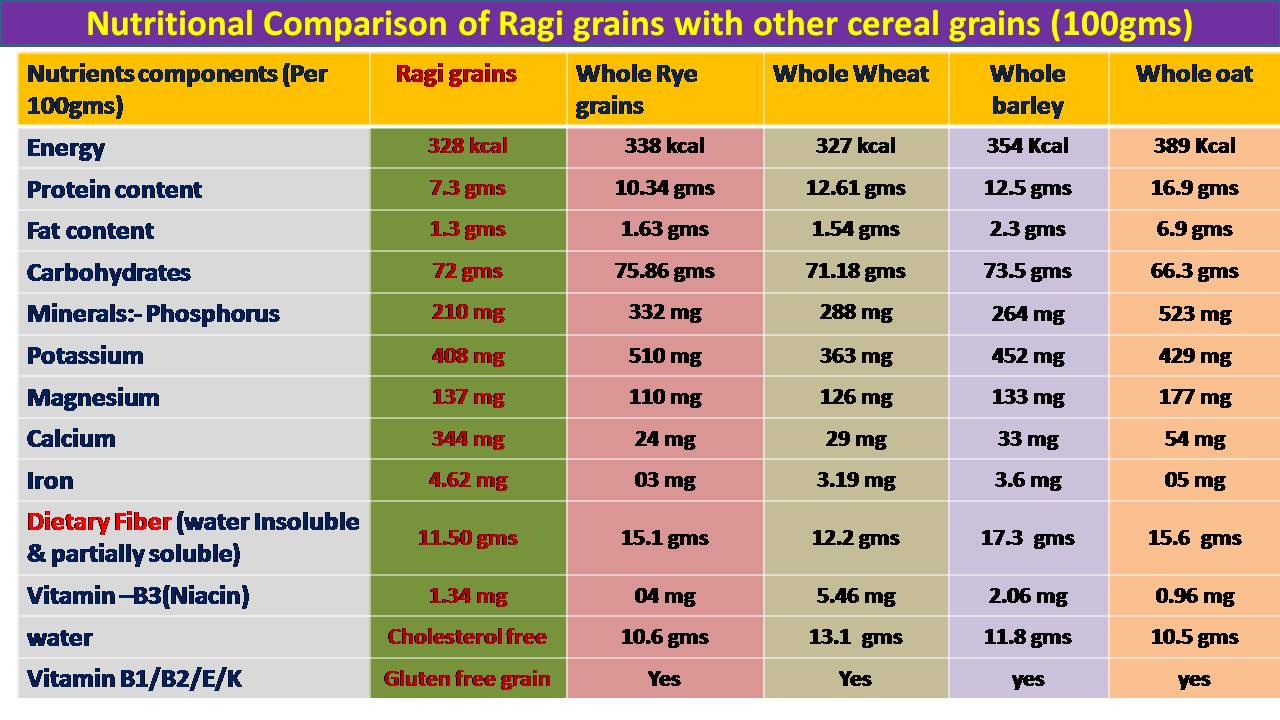
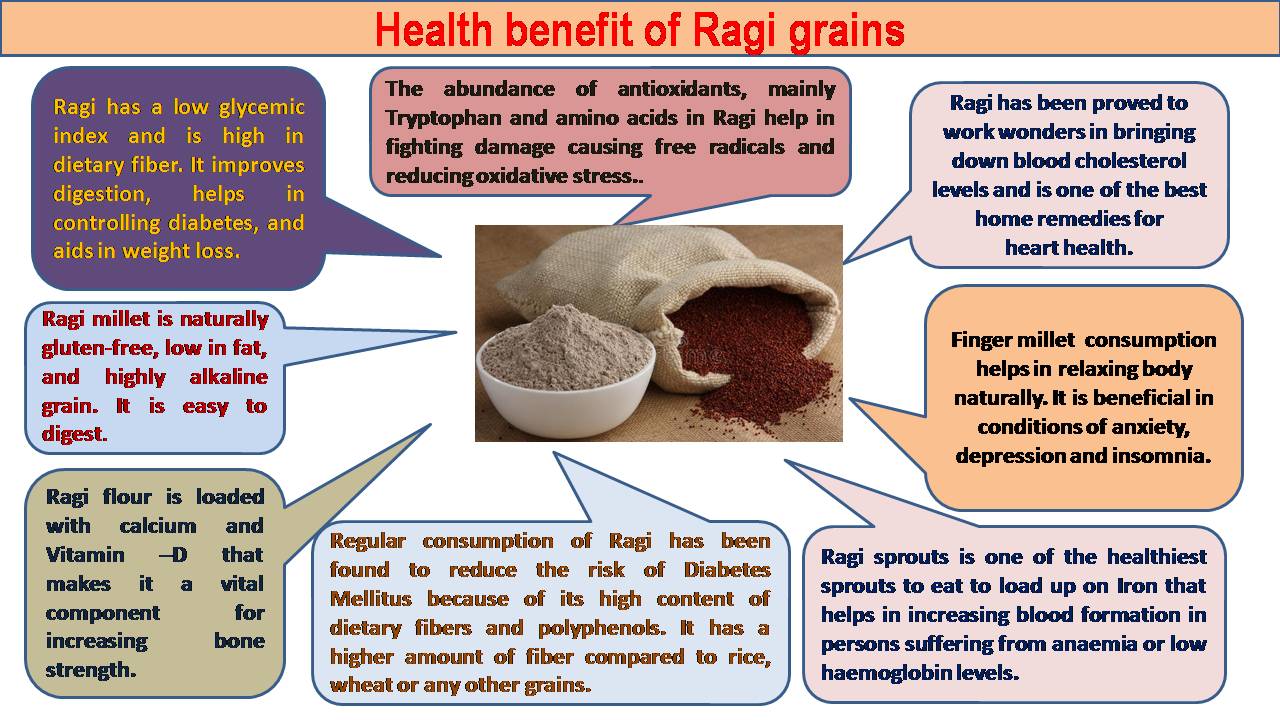
Culinary use of Ragi grain & Ragi flour
Since the husk or hull of Ragi grain is inedible, it is removed before milling to make ragi flour. Ragi grain is a versatile food grain used to make sprouts, microgreens, malted and grounded into flour to make porridge, several snacks, ladoo, chowder, ragi muddu etc.
Ragi or finger millet has been used since ancient times across African countries as well as India. It is used to make fermented beverage like:-
- Chikokivana- Finger-millet based alcoholic beverage made in Zimbabwe
- Merissa- A popular finger millet based alcoholic drink in Sudan
- Chaang- A traditional alcoholic-beverage prepared from finger millet and consumed widely in Nepal and North Eastern India.
- Pombe- Traditional beer produced from finger millet in Tanzania
- Kimpumu- An alcoholic beverage produced from finger millet in southern Tanzania
Malted ragi can be grounded into flour to prepare hot drinks with milk or chocolate.
It is usually mixed or combined with other grain such as whole wheat, rice, bajra, jowar etc to make it more healthy & nutritious breakfast food items such as Idli, dosa, conjee, poori, paratha, snacks, upma, Roti & paratha etc. The cereal is gluten-free and highly suitable for those who are gluten or lactose intolerant. Besides this, it can easily become a part of your daily diet in the form of chappatis or as porridge for breakfast
This super grain is usually serve as a baby or infant food due to rich in calcium, iron & dietary fiber , Non-gluten etc. Ragi grain is malted & then grounded into flour. Its flour is used to make flat breads, Roti, chapatti or paratha, Dosa etc.
Its flour is also used to make several baked products such as cookies, biscuits, cakes, muffins, crackers, multigrain breads, ragi breads and other sweet items such as Ragi ladoo, burfi, sheera, kheer etc.
Ragi flour is also made in the form of pancakes with chopped onions and tomatoes.
In Karanataka, Ragi is extensively used to prepare one of the traditional food items called Ragi Mudde (Ragi ball) which is prepared by cooking the Ragi flour with water to make dough like consistency and steamed . It is often consumed with sambar, saaru , curries or spicy meat gravies. In the Malnad region of Karnataka, the whole ragi grain is soaked and the milk is extracted to make a dessert known as keelsa.
Tamil People prepare Ragi Kanji which is basically porridge whereas people of Andhra Pradesh prepare Ragi Muddha (Ragi ball) which is eaten in the morning with chilli, onions & sambhar. In kerala, Ragi flour is used to make puttu which is a traditional kerla dish.
Ref:-
- International crop research institute for semi arid tropics(ICRISAT)
- http://www.aicrpsm.res.in/
- https://www.scielo.br/scielo.php?script
- springer link
- https://kitchensofhistory.wordpress.com/
- Agriculture statics at a glance 2018 report published by Ministry of Agriculture & Farmer welfare, Govt of India
- Hindavi, The Kitchens of Indian History
Journal of agriculture science, volume -10
Department of Agricultural Economics, University of Agricultural Sciences, GKVK, Bangalore, Karnataka, India
Science direct
Research gate
Wikipedia
Healthline
Spruceeat
NDTV Food
BBC Food
Times of India
